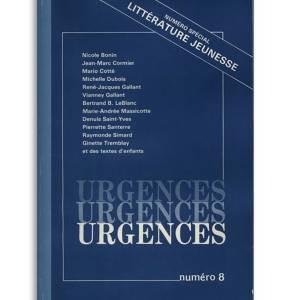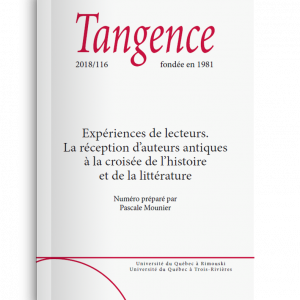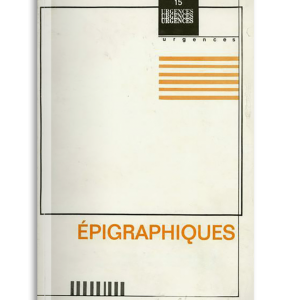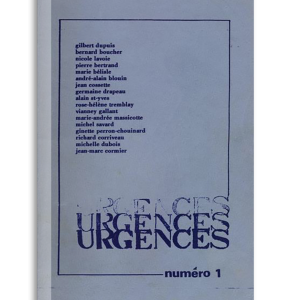Poetry as “image.” Uses and values of the word in the critical discourse of French poets
Isabelle Chol and Anne Reverseau
If reflections on the image are nothing new, whether they relate to the field of rhetoric or aesthetics or to the physiology and psy chology developed in the 19th century, the word occurs with particular frequency during the first third of the 20th century, marked by the twilight of symbolism, esprit nouveau and the first avant-gardes. It belongs within discourses that attempt to re-evaluate the “means” of poetic creation and, more broadly, to define its contours, notably in relation to the visual arts. This article proposes to study the values and issues surrounding the word “image” in the critical discourse of French poets and, in so doing, examine why and how different types of images were invoked as models in the French poetry of the interwar period. Thus, the issue is to analyze the shifts between the values of the word “image”, which, owing to its multiple meanings, can encompass the visual arts and poetry. Regarding the latter, it refers to a specific means of poetic creation and to poetry in general, which was then understood beyond its linguistic boundaries.
Reflecting on cinema : a close look at the 1925 dual issue of Les Cahiers du mois
Karine Abadie
In the 1920s, when cinema in France was becoming an increasingly popular form of entertainment and representation, texts in different forms were submitted to cinema magazines, literary journals and general publications. Writers participated in the development of this discourse by proposing reflective texts, somewhere between essays and criticism, which were strongly influenced by journalistic practices and requirements. Our article explores the nature of these texts by focusing on the dual issue of the review Les Cahiers du mois published in 1925. Thus, we can identify points of convergence between the reflections and forms and examine the options chosen to support diverse ideas on the subject of cinema.
Cinema in the eye and pen of the surrealist poet Robert Desnos
Carole Aurouet
Robert Desnos developed an immediate passion for the cinematograph, which was invented in 1895, five years before his birth. Thanks to this fierce enthusiasm, he embraced the new medium in two ways. On one hand, he wrote film reviews, analyses of filmmakers’ works, and articles dealing with issues outside the films themselves : thus, between 1923 and 1930, he wrote more than eighty articles. On the other hand, he authored some twenty scenarios of which only four were published in his lifetime (1925 to 1933). Based on an analysis of this body of work, this study proposes : first, to examine how Desnos viewed cinema (How does this new medium impact the poet ? What does it represent for him ? What are his likes and dislikes in terms of cinema ? What thinking does he develop regarding cinema ?) ; and second, to analyze the scenarios themselves (What is the poet doing with cinema ? How does he attempt to use cinema to develop a new language ? How do his cinematographic promises fare in the face of reality ?). These considerations enable a certain understanding of the themes and motifs that move correlatively between the critical and artistic contexts of production.
“Nous voilà tous…” : Raymond Queneau and cinematic creation
Marie-Claude Cherqui
Having accompanied his father regularly to the cinema in Le Havre during the First World War, Raymond Queneau (1903-1976) became, upon arriving in Paris, a regular patron of salles oscurres (dimly-lit halls). “Nous voilà tous…” (Here we all are…), a short surrealist text published in 1989 in the Bibliothèque de la Pléiade together with a number of yet unpublished poems and texts, is a poetic tribute to silent film. Not analyzed to date, it presents as a foundational text for anyone interested in the treatment of cinema in Queneau’s work. The author held the cinematograph to be a major discovery and identified the figures in his cinematographic pantheon who, via their diverse forms and numerous variations, would fuel his literary and poetic work. This article aims to examine how these motifs gradually developed, recurred and evolved to constitute a highly original set of ideas on cinematic expression in the literature of the time.
Writing in images. Pierre Bost’s approach to interwar cinema
François Ouellet
A prominent writer and prolific journalist in the interwar period, Pierre Bost was responsible, notably, for the cinematographic chronicles of the Annales politiques et littéraires from 1930 until the war and for those of the weekly publication Vendredi from the first to last issues (November 1935 to December 1938). Bost was an early film viewer and a critic sensitive to the emancipation of film and to the medium’s intrinsic qualities. Our objective is to demonstrate Bost’s approach to cinema, his conception of film and his wish to underscore the characteristics that make it a perfectly independent art form. The treatment of images plays a determining role at the heart of this approach.
“They don’t reach me” : Nadja or the elusive photograph
Frédéric Canovas
André Breton’s Nadja is a text emblematic of modern literature in that, among other reasons, the narrative is accompanied by 48 black and white photographs punctuating the meeting between the narrator and a young woman. Many critics have tried to decipher the meaning of these photographs and fit them into different reading schemes so as to reveal certain elements that are left unsaid in the text. Our study uses three studies published in the last thirty years regarding the photography in Nadja to show how any attempt to interpret the photographs is bound to fail—or simply generate confusion and ambiguity—and raises more question than it answers. In aiming for a more disturbing narrative, Breton clouded the issue and created a system of meaning difficult to grasp for both himself and his readers. Those attempting to fit the photographs in Nadja into a more comprehensive system run the risk of projecting their own personal tendencies on the textual and visual elements in the book, resulting in a reading characterized more by its subjective aspects than its scientific rigour.
In the viewfinder of a director-playwright : Jacques Copeau and the stage image (Vieux-Colombier, 1919-1924)
Clara Debard
Director of the Vieux-Colombier in Paris, Jacques Copeau staged 17 new French plays within its walls between 1919 and 1924. What visual choices were used ? Archives and manuscripts in the Bibliothèque nationale de France identify the stage creations for Paquebot Tenacity and Michel Auclair by Charles Vildrac, L’œuvre des athlètes by Georges Duhamel, Plaisirs du hasard by René Benjamin, Bastos le hardi by Léon Régis and L’imbécile by Pierre Bost. Although there are no references to cinema—which Copeau viewed as inferior to theatre—in his sets, props and costumes, he constructs an ingenious network of still images, paintings and photographs within his mise-en-scènes. With La maison natale, Copeau the playwright associates text and performance for the first time by assuming the role of a half-mad old man, a metaphor for the creator, who, ensconced in the attic of a squabbling family, operates a miniature stage. By means of this particular play, he illustrates his conviction that games with images and objects are a point in common among children, actors, playwrights and directors, and therefore establish essential connections with the audience.






